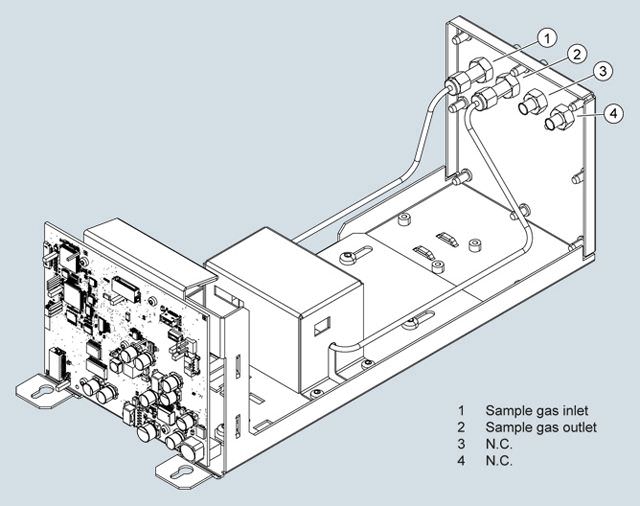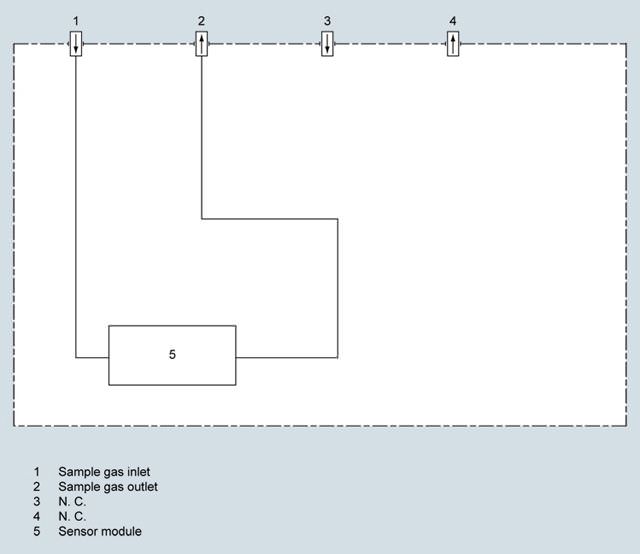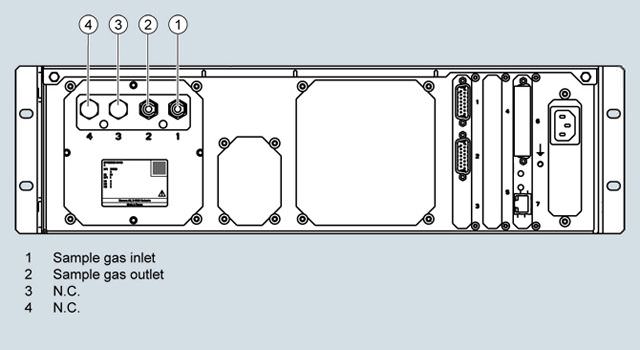Analyzer module CALOMAT 7 Siemens
Область применения
Application areas
- Pure gas monitoring (0 to 0.5 % H2 in Ar)
- Protective gas monitoring (0 to 2 % He in N2)
- Hydroargon gas monitoring (0 to 25 % H2 in Ar)
- Forming gas monitoring (0 to 25 % H2 in N2)
- Gas production:
- 0 to 2 % He in N2
- 0 to 10 % Ar in O2
- Chemical applications:
- 0 to 2 % H2 in NH3
- 50 to 70 % H2 in N2
- Wood gasification (0 to 30 % H2 in CO/CO2/CH4)
- Blast furnace gas (0 to 5 % H2 in CO/CO2/CH4/N2)
- Bessemer converter gas (0 to 20 % H2 in CO/CO2)
Обзор
The CALOMAT 7 analyzer module is primarily used for quantitative determination of H2 or He in binary or quasi-binary non-corrosive gas mixtures.
Concentrations of other gases can also be measured if their thermal conductivity differs significantly from their accompanying gases, such as Ar, CO2, CH4.
Дизайн

Structure of CALOMAT 7
Versions – parts wetted by sample gas
Gas path | Material | |
|---|---|---|
With pipes | Gas connection | Stainless steel, mat. no. 1.4571 |
Clamping rings and union nut (set) | Stainless steel, mat. no. 1.4401 | |
Sample gas pipes | Stainless steel, mat. no. 1.4404 | |
Sensor mounting block | Stainless steel, mat. no. 1.4571 | |
Sensor | Si, SiOxNy, AU, epoxy resin, glass | |
Gasket, contained in the sensor module | Perfluorelastomere FFKM | |
Gas path

CALOMAT 7, gas path
Способ действия
The measuring method is based on the different levels of thermal conductivity of gases. CALOMAT 7 analyzer modules work with a micromechanically produced Si chip, the measuring membrane of which is equipped with thin-film resistors.
The resistors contained in the diaphragm are regulated for constant temperature. The amperage required fluctuates in accordance with the thermal conductivity of the sample gas. This raw value determined in this way is processed further electronically to calculate the gas concentration.
The sensor is in a thermostatically controlled stainless steel enclosure in order to suppress the effect of the ambient temperature. To rule out flow influences, the sensor is mounted in a bore hole next to the flow channel.
Note
The sample gases must be fed into the analyzers free of dust. Condensation (dew point sample gas < ambient temperature) is to be avoided in the sample chambers. Therefore, the use of gas modified for the measuring tasks is necessary in most application cases.

CALOMAT 7, mode of operation
Essential characteristics
- Four measuring ranges which can be freely configured, even with suppressed zero, all measuring ranges are linear
- Smallest spans down to 0.5 % H2 (with suppressed zero: 95 to 100 % H2) possible
- Autoranging or manual measurement range switchover possible; remote switching is also possible
- Measured values can be stored during calibration
- Time constants can be selected within wide ranges (static/dynamic noise suppression); i.e. the response time of the device can be adapted to the respective measuring task.
- Short response time
- Low long-term drift
- Measuring point switchover for up to 6 measuring points (programmable)
- Measuring range identification
- Measuring point identification
- External pressure sensor can be connected – for correction of variations in sample gas pressure
- Automatic measuring range calibration can be configured
- Operation based on the NAMUR recommendation
Cross-interferences
To determine the cross-interferences of accompanying gases with several interfering gas components, you must know the sample gas composition. The following table contains the zero offsets for the carrier gas N2 as H2 equivalent values with 10% interference gas
Interference gas | H2 equivalent values with 10% interference gas |
|---|---|
CH4 | +1.77% |
C2H6 | +0.47% |
C3H8 | -0.28% |
CO | -0.10% |
CO2 | -0.84% |
O2 | +0.19% |
N2O | -0.83% |
NH3 | +1.45% |
Ar | -1.22% |
He | +6.32% |
SF6 | -2.15% |
SO2 | -1.47% |
Synth. air | +0.40% |
H2O (3%) | +0.38% |
Zero offset in the system H2 in N2
If you are using accompanying gas concentrations ≠ 10%, you can use the corresponding multiples of the respective table value as a good approximation. This procedure applies depending on the type of gas for an accompanying gas concentration range up to approx. 25%.
The thermal conductivity of most gas mixtures has a non-linear response. Even ambiguous results can occur in specific concentration ranges, e.g. with H2 in He mixtures.
In addition to the zero offset, the accompanying gas also affect the characteristic curve. For most gases, however, the effect on the characteristic curve is negligible.
Особенности
- Small T90 time due to micromechanical-produced Si sensor
- Universally applicable hardware basis, high measuring range dynamics (e.g. 0 to 0.5 %, 0 to 100 %, 95 to 100 % H2)
- Integrated correction of cross-interference, no external calculation required
- Open interface architecture (analog, digital, Ethernet)
- SIMATIC PDM network for maintenance and servicing information (optional)
- Measuring instruments: purging is possible, IP20/IP65, long service life even in harsh environments
Схема подключения
Gas connections

CALOMAT 7 gas connections
The sample gas connections are made of stainless steel with material no. 1.4571 and are designed as connecting fittings with a pipe diameter of 6 mm.
Технические данные
The technical specifications are based on the definitions of DIN EN 61207-1.
Unless specified otherwise, the data listed below relates to the following measurement conditions:
Ambient temperature | 25 °C |
Atmospheric pressure | Atmospheric (approx. 1 000 hPa) |
Sample gas flow | 0.6 l/min (or Nl/min) |
Reference application | H2 in N2* |
Site of installation | Vibration- and impact-free |
* The technical specifications for time and measuring response as well as for the influencing variables can sometimes differ significantly for other gas mixtures
General | |
Weight | Approx. 3 kg |
Measuring ranges | |
Number of measuring ranges | Max. 4; parameters can be assigned freely |
Parameters can be assigned in the measuring ranges | |
| 0.5% H2 in N2 |
| 100% H2 in N2 |
| 5% (e.g. 95% to 100%) H2 in N2 |
Gas inlet conditions | |
Sample gas pressure | 700 to 1200 hPa (abs.) |
Pressure drop between sample gas inlet and sample gas outlet | < 50 hPa at 1.5 l/min |
Sample gas flow | 30 to 90 l/h (0.5 to 1.5 l/min) |
Sample gas temperature | 0 to 70 °C |
Sample gas humidity (rel. humidity) | < 90% (condensation inside the gas path is to be avoided) |
Sample chamber temperature | |
Standard version | Approx. 72 °C |
Time response | |
Warm-up period at room temperature | < 30 min (max. accuracy after 2 h) |
Response characteristics | |
| < 2.5 s |
| < 0.5 s |
| 0 to 100 s |
Measuring response | |
Output signal fluctuation with device-internal signal damping of 1 s | ≤ ± 0.5% of the smallest span acc. to nameplate (σ < ± 8.33 vpm H2) |
Detection limit | ≤ 1% of the smallest measuring span according to nameplate |
Measured-value drift | ≤ ± 1%/week of smallest span according to nameplate or ≤ 50 vpm H2 / week, whichever is greater |
Repeatability | ≤ ± 1% of the current measuring span or 100 vpm H2 |
Linearity error | ≤ ± 1% of the current measuring span or 100 vpm H2 |
Influencing variables | |
Ambient temperature | ≤ ± 0.5%1)/10 K of the current measuring span or ≤ ± 50 vpm H2 / 10 K |
Sample gas pressure | ≤ ± 0.5 %1) of the current measuring span/1% pressure variation or ≤ ± 50 vpm H2 / 1% pressure change |
Sample gas flow | ≤ ± 0.2% of the smallest possible measuring span with a change in flow of 1 dl/min within the permissible flow range |
Accompanying gases (interference gases) | The interference gas sensitivity depends on the application and must be determined in each case except for applications with blast furnace gas / converter gas / wood gasification (pre-adjusted). |
Supply voltage | ≤ ± 0.1% of full-scale value (within the nominal range of use) |
Electrical inputs and outputs | |
Analog and digital interfaces | See base unit |
Climatic conditions | |
Storage and transport | -30 to 70 °C |
Permissible ambient temperature (during operation in base unit)2) | 0 to 50 °C |
Relative humidity (RH) during storage, transport or operation | < 90% (condensation on the installed components is to be avoided) |
Gas connections | |
Connection fittings | Pipe connection with 6 mm outer diameter |
Materials of wetted parts | |
Gas connection | Stainless steel material no. 1.4571 |
Clamping rings and union nut (set) | Stainless steel material no. 1.4401 |
Sample gas pipes | Stainless steel material no. 1.4404 |
Sensor mounting block | Stainless steel material no. 1.4571 |
Sensor | Si, SiOxNy, Au, epoxy resin, glass |
Gasket, contained in the sensor module | Perfluorelastomere FFKM |
1) Values less than the detection limit are not useful
2) Restriction for installing an ULTRAMAT 7 analyzer module: 5 to 45 °C







 Ответ от производителя может занять до 5 дней и более.
Ответ от производителя может занять до 5 дней и более.

